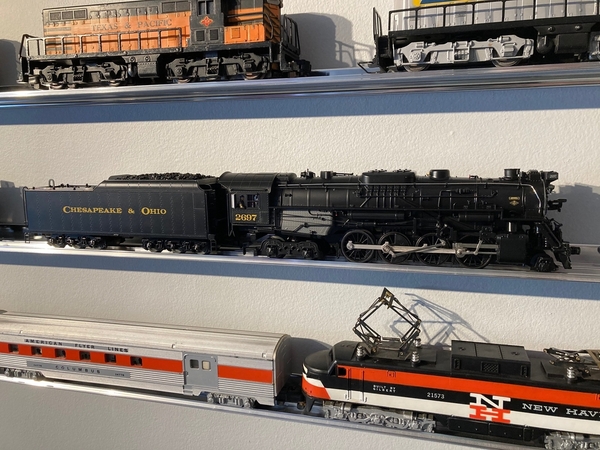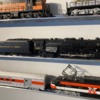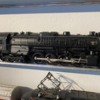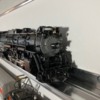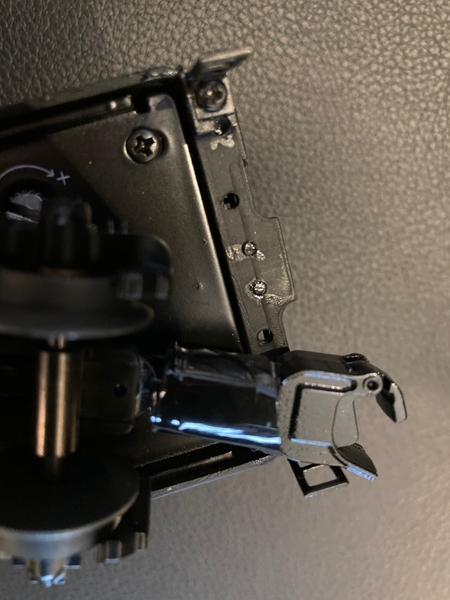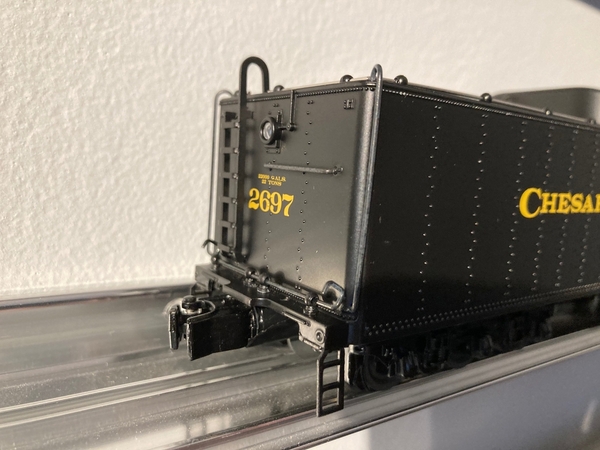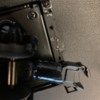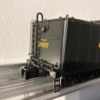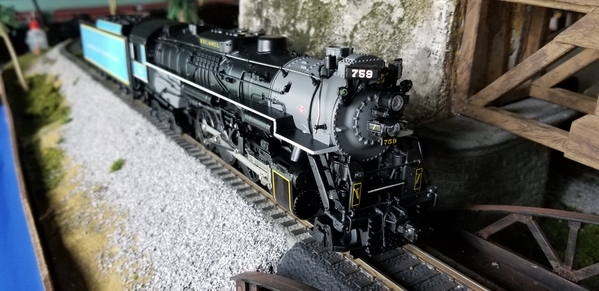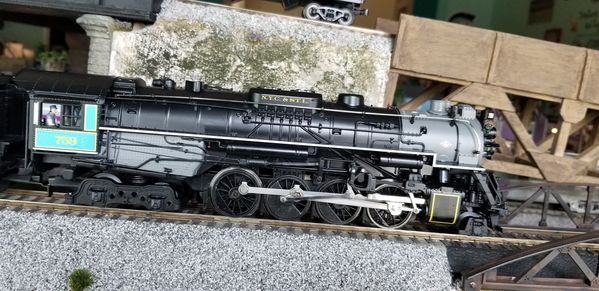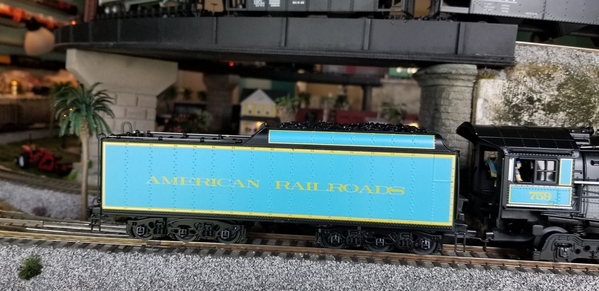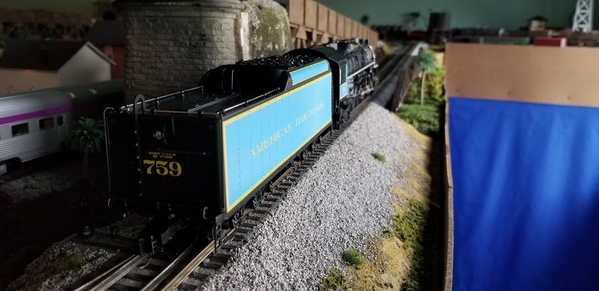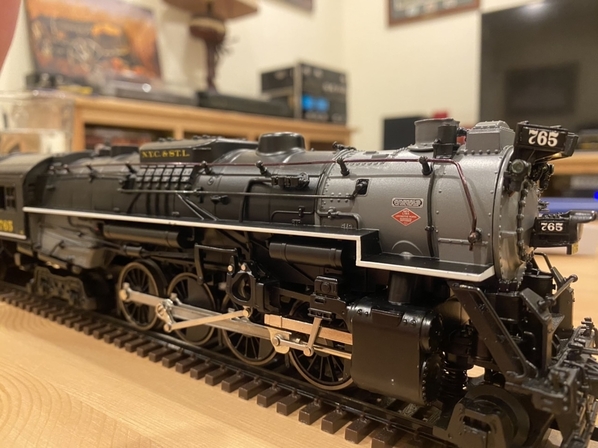The C&O arrived. I'm definitely disappointed with the location of the headlight based on the original Dave Olson drawings but the rest seems well done at first glance. Can't run it at the moment.
@FlyerRich posted:
Probably because the 2697 was an ex-Pere Marquette locomotive and I don't believe the C&O lowered the headlights on the ex-PM 2-8-4's. I think this was brought up when the CAD drawings were first published.
It'll be interesting to see if the NKP 765 version gets the Mars light like the AR 759 is supposed to have.
Rusty
Well now that you mention it Rusty, I feel better now since it matches the photo in this link:
Yeah ! Lionel is really building these ! Thanks for posting the real-life photos ! Be sure to let us know how it runs ! (This made my day... still waiting on the NKP version)
That turned out pretty decent. That's not a bad example of an AMC Berk at all. Comparing the model to the photos of the real C&O 2697 looks like they got most of the main features correct or really close. I think it passes the "good enough" eyeball test.
Can you flip the tender over and take a photo of the coupler area please? Wondering if they did the Kadee mounting pad or not. Hopefully it has the NKP 765 RailSounds file with 4 chuffs per rev.
Patiently waiting on my Erie and NKP to be delivered.
Thanks.
I do wish Lionel would find their can of graphite paint instead of the tarpon(?) gray they're currently using on the smokebox and firebox, though. Well, that's what airbrushes are for...
Rusty
@jonnyspeed posted:Can you flip the tender over and take a photo of the coupler area please? Wondering if they did the Kadee mounting pad or not. Hopefully it has the NKP 765 RailSounds file with 4 chuffs per rev.
Attachments
Thanks FlyerRich. The rear of the tender looks great. Unfortunately, those holes are not for a coupler box as promised by Lionel on this Forum. Looks like I'll be modifying mine like I did to my Flyonel Y-3.
@Chuck K posted:Unfortunately, those holes are not for a coupler box as promised by Lionel on this Forum. Looks like I'll be modifying mine like I did to my Flyonel Y-3.
These came with the metal bracket and screws for attaching the scale coupler. Highlighted in green. The mounting holes are seen in the die-cast part of the rear of the tender.

Attachments
@Rusty Traque posted:Probably because the 2697 was an ex-Pere Marquette locomotive and I don't believe the C&O lowered the headlights on the ex-PM 2-8-4's. I think this was brought up when the CAD drawings were first published.
Correct. The C&O is supposed to have the center headlight.
@Dave Olson posted:These came with the metal bracket and screws for attaching the scale coupler. Highlighted in green. The mounting holes are seen in the die-cast part of the rear of the tender.
Sorry Dave. I should have waited until I received mine. After I ordered mine, I became aware that this feature was not listed in the catalogue, and so I have been anticipating that these would come without scale coupler adaptability. I am delighted to see that the catalogue was wrong and the originally promised adaptability is there.
@Dave Olson posted:These came with the metal bracket and screws for attaching the scale coupler. Highlighted in green. The mounting holes are seen in the die-cast part of the rear of the tender.
Credit where credit is due... Thanks for following through Dave. This model turned out better than expected. I have two on order and I think I might add a couple more. Is it too early to talk about the next Legacy scale model? After seeing this model, I say bring it on!
I also have two on order. Looks like a great engine.
Still waiting for my shipping info. Card has a pending charge. No word yet on shipping... sigh lol
@richabr posted:
Well, that answers my question about a Mars light on the 765 version. At least Lionel added the proper NKP slatted pilot. It wasn't too clear about the pilot when the Berks were announced.
Looks good, though. Waiting for mine to show up at my LHS.
Rusty
The only thing I don't quite get is why the shiny handrails? Pretty sure they should be black. Easy fix though so not a big deal.
@jonnyspeed posted:The only thing I don't quite get is why the shiny handrails? Pretty sure they should be black. Easy fix though so not a big deal.
I had the same thought. The other feature that would have been useful is an extendable (kinematic) drawbar like the one on the Y3. Given features and appearance, it would appear that the Y3 remains the best AF steam engine ever done by Lionel. However, the Legacy Berk is less costly. Someone should post about the Berk's performance - how well it runs and sounds. I have a Nickle Plate Road 765 coming and, like many of you, am looking forward to receiving and operating it.
Enjoy!
Bob
@Bob Bubeck posted:I had the same thought. The other feature that would have been useful is an extendable drawbar like the one on the Y3. Given features and appearance, it would appear that the Y3 remains the best AF steam engine ever done by Lionel. However, the Legacy Berk is less costly. Someone should post about the Berk's performance - how well it runs and sounds. I have a Nickle Plate Road 765 coming and, like many of you, am looking forward to receiving and operating it.
Enjoy!
Bob
I should have mine by Fri or Sat. If nobody else has posted a video by then I'll shoot one and post it.
@richabr posted:Got mine today. The detail difference is as expected. A few comparison pics.
A lot of added detail in the pilot.
Coal and rivet detail in addition to wire handrails.
A nice job by Lionel, can't wait to run it in the future.
Rich
A stark contrast for sure. Delighted to see that the Legacy brand is being upheld by the detail on this one.
I picked up the Nickel Plate Berkshire from Charles Ro yesterday. I was hoping it had the Mars light and a bit disappointed that it did not. This was on feature that Dave Olson had mentioned as being particularly cool when the locomotive was running and what I remember seeing as a kid when they blasted through Hobart, Indiana. The locomotive is packed tightly in its case and "locked in" with gray blocks to keep it and the tender from moving around in the slightest. Once the locomotive was out of the box, I noticed a tiny screw and a black plastic coupler in the styrofoam tray. Because neither was in the small plastic pouch containing two spare traction tires and the scale coupler bracket, I assumed the the screw was loose and fell of the front. The screw seemed to be magnetic, which made it a bit easier to reinstall. The unpainted shiny hand rails made the locomotive and tender seem more toylike, but as Jonathan points out, they can be painted.
The tender was to get a Kadee scale coupler installed, but the screw holding the large electro-coupler was accessible only when the body of the tender was removed. Even when I removed the body, the rear tender truck would not rotate enough to see the screw . A c-clamp holds the truck shaft through the frame, and this is hard to remove while being careful not to damage the wires from the truck through the shaft to the circuit boards on the tender frame. The electro-coupler came off easily, but its plug to the circuit board is too thick to pass through the truck shaft--I had to cut the wires to completely remove the coupler and its plug.
The Kadee scale bracket comes with six screws: two for attaching the Kadee coupler to the bracket, two longer screws to attach the bracket to the body of the tender, and two shorter screws for the same attachment. The longer screws extend beyond the tender frame and are visible, so the shorter screws are the ones to use. (In my packet there was only one small screw and three long screws. Someone miscounted.) The bracket screw holes did not line up exactly with the holes in the tender. (Flyerrich's photo of the bottom of the tender shows two plugged holes that may have been a correction to a mistake in alignment. Although visible on the bottom of the tender, they do not appear on the surface.) I had to bend the bracket slightly to get it to match up with the holes on the tender.
The coal in the tender is held together and to the body with a yellowish glue. One corner of the coal load had lifted slightly from the body, but an easy push put it back in place. There were a few strands of the glue that lay across the edge of the coal pile, resting on the side of the tender. I lifted those with a tweezers to pull them off.
Once I placed the locomotive on the track, it did not respond to DC current, either forward or backward. (The Y-3 2-8-8-2 sometimes balks at DC forward but always responds to DC reverse.) Turning power on/off, forward/reverse, increasing voltage to 14 volts--nothing got any movement. I then programmed the locomotive for the Legacy format and tried the Legacy control. The locomotive responded immediately. In fact, the response was a bit faster than I expected until I set momentum to high. Slow speed operation either forward or backward was excellent. The sound level was at its maximum volume setting, so I turned it down a half rotation. Setting the train brake slider on the left of the Cab controller to make the locomotive labor more, as if pulling a heavy load, brought out laboring sounds more noticeably than any of the other American Flyer Legacy steam locomotives. The bell was that standard sound, but the whistle was marvelous--quite a bit different from the Challenger, Mikado, or Y-3 and just what I remembered as a kid when that sound alerted my brother and me to race on our bikes to see/feel/smell those Berkshires pound through the nearest rail crossing. There are brake sounds when the locomotive is brought to a halt rather quickly, but not when slowing down at a more practical rate. No more "elephant squeel" at any reduction in speed.
I put the programmed Berkshire back on the track to try DC power again, and it now responded to the controls. The Y-3 "woke up" at about 5 volts, but the Berkshire needed about 7 volts to light up and react to more voltage to move.
In the styrofoam case there is a plastic smoke fluid funnel and a metal wrench for removing drive rod screws if the traction tires ever need replacing. The explanation for this tool is on page 31 of the manual. This is a nice touch that Lionel included and should have emphasized as an additional feature.
The paint and detailing are first rate, as usual on Legacy models. The builder's plate is fully legible under a microscope, and there is added--not molded--piping everywhere across the boiler. The cab bulkhead is highly detailed and much more visible in this model than the equally detailed Challenger with its back doors closed.
I have to say I was initially disappointed with the lack of a Mars light, and then the small flaws I encountered. It's natural to compare the Legacy Berkshire to the previous Legacy steam engines and find a few deficiencies--until one reminds himself that the Berkshire is nearly half the price, is as fully detailed, and is designed to work on TMCC, Legacy, AC, DC, and DCC. It is a wonderful addition to our scale--a fully loaded steam locomotive that costs the same as a Legacy diesel! Lionel has done a great job with this one.
I received my American railroads version today. It arrived with a wheel in the pilot hanging loose, but I was able to snap it back in. It has the Mars light which is very cool. This, the cab detail and lights and the whistle are my favorite features.
Like TOKELLY, I installed a scale coupler. I removed the tender shell (6 screws), unclamped the C clamp holding the rear truck on, unscrewed the electro coupler from the truck, and unplugged the wire connector from the circuit board. As TOKELLY mentioned, the electro coupler’s wire connector will not fit through the hole in the chassis where the truck attaches, but instead of cutting the wires, I pulled them out of the connecter so they could be snapped back in (I sell these on ebay).
I also had to bend the coupler pad bracket because it does not fit the hole locations in the tender.
I had a lot of trouble trying to program it in Legacy. Eventually I got it to take the number ID I was trying to assign. The problem is it doesn’t respond reliably to my Legacy signal. I have to try repeatedly to get it to start up or shut down, the speed control is all over the place, and I have no control over the smoke volume or forward/reverse. I tried one of my other Legacy locos just to make sure something hasn’t gone haywire, but it ran fine. So the Berk will have to be sent in for service, but I will run it for several hours first to see if any other issues arise before shipping it off to Concorde.
The good news is that I then ran it with DCC, and it ran perfectly.
Here’s a video and pictures.
Attachments
I really like that whistle and the strobe. Your layout looks great! Good job ballasting the FasTrack.
@Chuck K posted:I had a lot of trouble trying to program it in Legacy. Eventually I got it to take the number ID I was trying to assign. The problem is it doesn’t respond reliably to my Legacy signal. I have to try repeatedly to get it to start up or shut down, the speed control is all over the place, and I have no control over the smoke volume or forward/reverse.
The good news is that I then ran it with DCC, and it ran perfectly.
Chuck, do the Flyer's use the handrails as antennas like the O gauge Steam. What you described sound a bit like one of the handrails may be grounding itself to the loco. Maybe check that all spacers/grommets are in place?
Just a thought since you say it does run fine on DCC
@EscapeRocks posted:Chuck, do the Flyer's use the handrails as antennas like the O gauge Steam. What you described sound a bit like one of the handrails may be grounding itself to the loco. Maybe check that all spacers/grommets are in place?
Just a thought since you say it does run fine on DCC
I am not sure. I have two other AF Legacy steamers, but I have never taken the boiler shell off to see. I do suspect it is an antenna issue though. I may get antsy and remove the shell to see if it is anything obvious, but the warranty can be pretty easily voided if you mess with them too much.
Do we know yet which roadnames have the Mars light and which don't? Obviously, C&O and NKP don't but American Railroads does. Anyone know about the rest?
@FlyerRich posted:Do we know yet which roadnames have the Mars light and which don't? Obviously, C&O and NKP don't but American Railroads does. Anyone know about the rest?
The catalog pictures only show the American Railroads with the Mars light.
I got my American Railroad Berk today. Chuck did a great job with photos so I won't go into appearance except to say that is a magnificent engine to look at. The detail is so much better than the FlyerChief engine, which I still like.
When I got mine out of the box the front truck wheels/axle and the clips that hold them were out of the truck. I put them back in and tried to address the engine. It shorted out. Since this wheel set picks up power from the track and one wheel is insulated I reversed the wheels and the short went away.
The engine ran perfectly after that using my Legacy control. The most amazing thing is its smoke output. I had it on low and it put out more smoke than any Fl;yonel engine I have had. The directions say to start with 20 drops by-the-way.
Great Job Lionel!!!!
A little frustrated with Charles Ro right now. My 765 NKP Berk was ordered in August 2019, and my order still shows as processing, while another member of our club ordered one two weeks ago and got it today.
So much for Lionel BTO.
Aflyer
@Aflyer posted:A little frustrated with Charles Ro right now. My 765 NKP Berk was ordered in August 2019, and my order still shows as processing, while another member of our club ordered one two weeks ago and got it today.
So much for Lionel BTO.
Aflyer
Ro usually orders a couple of extras for stock.
Rusty
@cswalter posted:The catalog pictures only show the American Railroads with the Mars light.
The was the faint hope that the Mars light would be added to the 765 model. Lionel occasionally changes features between catalog and production.
Rusty
@Aflyer posted:A little frustrated with Charles Ro right now. My 765 NKP Berk was ordered in August 2019, and my order still shows as processing, while another member of our club ordered one two weeks ago and got it today.
So much for Lionel BTO.
Aflyer
Same here. ordered a year ago, still no shipment. Credit Card was charged Sunday night. ...sigh...
@Erie-modeler posted:Same here. ordered a year ago, still no shipment. Credit Card was charged Sunday night. ...sigh...
Give them a call. I ordered one Monday, got it Thursday this week. No notice of shipment, it just showed up! Call them and see what's up. If it has been shipped, they can send you the tracking info and you can see what happened to it.
Mike
Mine arrived today. I must say I am beyond pleased with this model! Here is a quick test run. I’m using a brand new Legacy system for control.
Attachments
Attachments
I was a little concerned about the sound of the whistle. It sounds a little too high to my ears, but after checking a couple of YouTubes, I'm guessing it's more the acoustics of the tender rather than the actual sound sample.
Over all, this appears to be a fine locomotive, second to the Y3. Several others have mentioned features that would have brought the Berk up to the Y3's level, but this Berk is nothing to sneeze at.
Any yes, blackening the handrails make a good thing even better.
My LHS is sort of at the bottom of the distributor's list so it may be a week or two before mine shows up.
Rusty
I have ridden the 765 many times. Trust me when I say that the whistle is spot on! It isn’t my favorite whistle if I’m honest, but it is very accurate. Lionel has a really good recording. I will be taking a look at the speaker when I’m installing the Kadee, but overall I am extremely pleased with the sound package, and anyone that knows me knows that I am a sound snob.
Also, remember that this test is on a hardwood table which brightens and reflects the sound. On a layout with scenery it sounds a little less sharp.
Here is a video I shot a few years ago when she came to town
Jonathan: I had to turn the volume down a notch with the Legacy because it was to loud. The speaker is adequate.
Rusty: You and your Y3. My Y3 has problems with it's smoke unit and screws keep falling out. You might even like the Berk better when yours gets there.
Headlights: I looked up the real engine for the 759 American Railroads engine and there were 3. So Lionel got it kind of right with 2.
@Roundhouse Bill posted:Jonathan: I had to turn the volume down a notch with the Legacy because it was to loud. The speaker is adequate.
Rusty: You and your Y3. My Y3 has problems with it's smoke unit and screws keep falling out. You might even like the Berk better when yours gets there.
Headlights: I looked up the real engine for the 759 American Railroads engine and there were 3. So Lionel got it kind of right with 2.
Same here Bill. It was so loud it actually hurt my ears this is about 50-60% volume.
@Roundhouse Bill posted:
Rusty: You and your Y3. My Y3 has problems with it's smoke unit and screws keep falling out. You might even like the Berk better when yours gets there.
Geeze, Bill. You make it sound like a crime that I think the Y3 is the bee's knees.... Sorry if you had problems with your Y3, mine has had no problems.
The Y3 has two major things going for it that make it a cut above: The kinematic drawbar that keeps the tender nice and close and proper graphite paint instead of the gray Lionel is currently using. And just for grins, make it three things... I'll also throw in blackened handrails.

I have no doubt I'll enjoy my Berk when it comes in. I'll probably deal with the gray paint and handrails after I get settled in my new digs.
@Roundhouse Bill posted:Headlights: I looked up the real engine for the 759 American Railroads engine and there were 3. So Lionel got it kind of right with 2.
Three headlights???? While the 759 (and 765) have a pair of sealed beam lamps in the Pyle headlight casing, it's still considered one headlight.
The other light is not a headlight but a Mars light, a signal/safety light that operates in a figure-eight pattern, operates independently of the headlight and was not always illuminated.
Rusty




